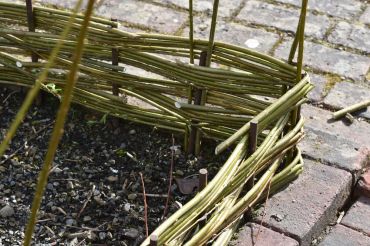
Wattle fencing has been around for centuries. It’s done by weaving thin branches through poles to make panels, and it goes right back to Neolithic times, so it’s a well-tried technique! Use a low wattle fence to define the edge of a bed and make a good wind barrier to protect young seedlings.
How to Weave Wattle Edging
You will need a pile of freshly cut stems, around 75cm-1m (2.5-3ft) long. Hazel and willow are traditionally used, but any long flexible woody stems are fine, as long as they are pliable and don’t snap when bent.
You will also need some reasonably straight and sturdy sections of branch or stem to act as posts.
-
Cut the wood you are going to use for your posts into lengths to suit the height of the edging you want to make, taking into account that part of the post will be buried underground.
-
Dig a shallow trench along the line where you want your edging to run.
-
Push the posts into the ground in the trench, spaced around 30-45cm apart. The posts may feel a bit wobbly at this stage, but they will be held in place once the stems are woven around them.
-
Weave the stems between the posts, in front of one post and behind the next, with each layer of stems sitting on the opposite side of the post to the layer below it.
-
Once the weaving is finished, trim off any ends sticking out that might poke into someone walking past.
Where to Get Stems for Weaving Wattle Edging
The stems used in wattle weaving come from coppicing woodland. Coppicing is the process of cutting established trees down to the base to produce new pliable stems that can be harvested for use. Coppicing is a recognized woodland management technique. Besides providing a sustainable source of wood, it also benefits wildlife by increasing the light levels in woodland areas, thus increasing the range of species that can flourish there.
You can buy coppiced stems and poles online from various organizations.
Garden Plants That Can Be Coppiced
If you happen to have suitable shrubs in your garden, you can also do your own coppicing.
Foxglove trees (Pawlonia), Indian bean trees (Catalpa), and smokebush (Cotinus) are often coppiced to produce bigger foliage. Dogwoods (Cornus alba and sanguinea) are coppiced in late winter to produce new colourful stems for the following winter. Beech, hazel, eucalyptus, willow, and hornbeam trees can all also be coppiced.
The best time to coppice is in late winter or early spring before the trees come into growth. Cut back all stems to within 5-7.5cm from the ground or to the previous year’s stubs.
Whatever you use to edge your beds, you’ll find tools and equipment to help in our centre. Visit us soon and give your garden a new look this summer!




